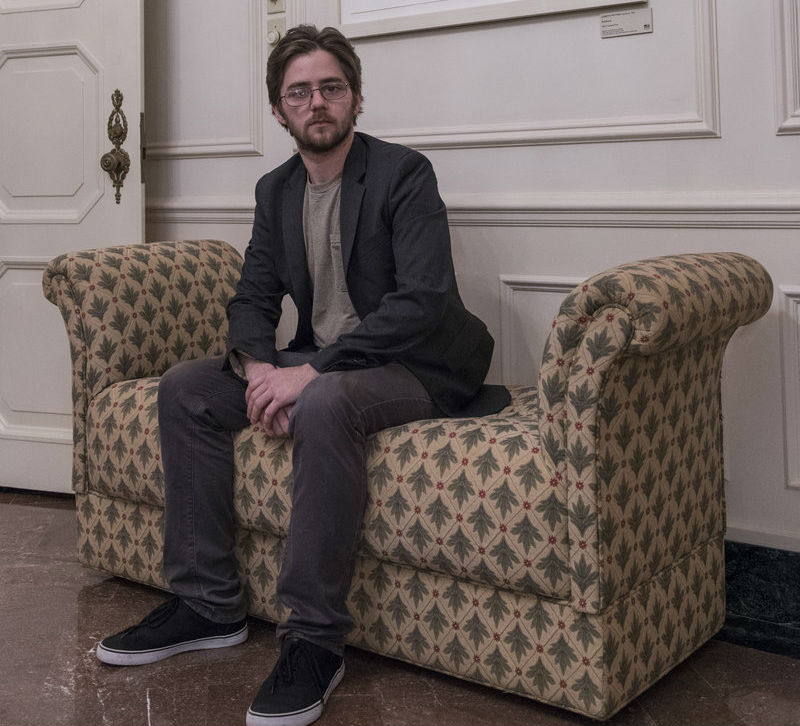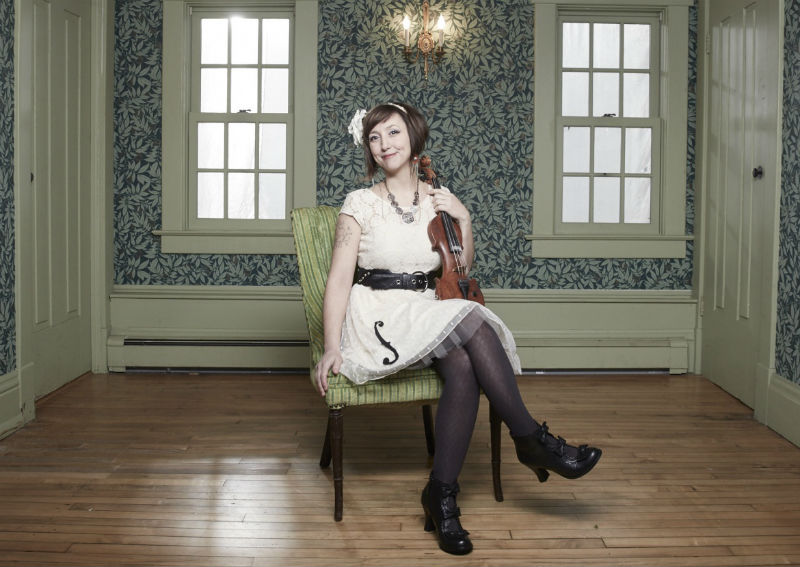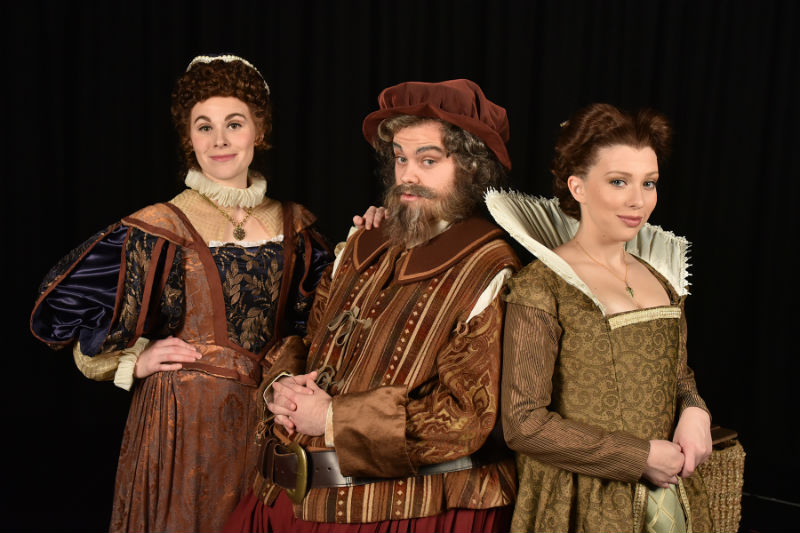Change & Growth: "Violet" at U-M's Arthur Miller Theatre

Violet is a musical that’s known both for its soaring gospel- and blues-infused score and for its social commentary about race relations. Originally written for Off-Broadway back in 1997, the show follows a young, facially disfigured Caucasian woman in 1964 who travels across the United States in the hopes of having her outward scars healed by a TV evangelist. Over the course of her journey, she meets and falls in love with an African-American man. “It’s about finding out who you are, accepting who you are, appreciating who you, and loving who you are. And then being able to navigate this world,” says Mark Madama, who is directing a production of Violet this weekend through the University of Michigan School of Music, Theatre, & Dance department.
Pop-up exhibit "What Were You Wearing?" at UMMA examined sexual assault

The last time I asked myself, “Was it what I was wearing?” was last Friday. I had been eating my dinner at the bar of a local restaurant when a man struck up a conversation with me. Eventually, he made a joke to the bartender about bringing me a “roofie colada.” The bartender responded disapprovingly. Then, the man doubled-down on his joke, adding, “Don’t worry; she won’t remember a thing.” As the evening went on, I couldn’t quite shake that joke. What Were You Wearing? is a pop-up installation that sets out to challenge the idea that sexual assault is somehow about clothing choice. On Monday, Dec. 4, this exhibit was at the University of Michigan Museum of Art, brought there in partnership with the HeForShe student organization.
Sonic Sculpture: Adam Shead's "Adiaphora Music," a master's recital

As someone with a bachelor's of music in percussion performance from Columbia College Chicago and, soon, a master's degree in improvisation from the University of Michigan, drummer Adam Shead sounds like an academic. But while growing up in South Bend, Indiana, it was hardcore punk that first informed Shead's attitude and artistic aesthetic. That combination of academic rigor and raw energy is what makes Shead's drumming such a potent force, which he'll get demonstrate live on Friday, Dec. 8, at U-M's Duderstadt Video Studio when he presents his master's recital, Adiaphora Music. The seven-part suite features 11 musicians along with Shead exploring his influences, which run from Chicago visionaries AACM, Ken Vandermark, and Tim Daisy to South Africa's Dudu Pukwana, and contemporary classical giants Morton Feldman and John Luther Adams to H.R., lead singer of the groundbreaking punk band Bad Brains. We talked to Shead about his philosophy, sound, and the meaning of Adiaphora Music.
Craft Services: A peek at Winter Art Tour 2017

For the past few years in Washtenaw County, the second weekend of December has been the time to shop for wonderful handcrafted goods from local artists at pop-ups, craft fairs, and studio shows.
An easy way to find out what’s happening where is to check out the stops on the second annual Winter Art Tour, which takes you to 10 venues across Ann Arbor and Ypsilanti where you can shop handmade goods from over 300 artists during the weekend of Dec. 8-10. There's a passport to get stamped as you visit each of the tour's locations, and if you hit at least four spots, you have a chance to win beautiful handcrafted prizes.
The event features two large craft fairs and several smaller studio sales across Washtenaw County:
Tiny Expo takes place at the downtown Ann Arbor District Library and is an annual holiday fair that features 45 artists and crafters selling their wares in a festive library space. You’ll find things such as jewelry, screen prints, knit goods, candles, kids items, and more. In addition to vendors, this one-day celebration also features Sweetwaters selling beverages and treats, and the Secret Lab will be set up with hands-on activities where you can do some screen printing, letterpress printing, card-making, and pom-pom making. (Dec. 10, 11 am-5:30 pm)
The Riverside Arts Center in Ypsilanti is home to DIYpsi, which hosts 90 vendors of the best in handmade from the Midwest, offering everything from jewelry to cutting boards to homemade peanut brittle. It’s a chance to enjoy handcrafted food and drinks while you get your shop on at this two-day show. New this year will be a make 'n’ take room with family-friendly art projects for all as well as a movie playing on loop at the Film House inside Riverside. (Dec. 9, 11 am-7 pm; Dec. 10, 12-6 pm)
If you’re looking for more art and smaller venues, there are plenty of wonderfully cozy venues on the Winter Art Tour that will be bustling with art and festivities.
The Third Annual Ypsi Alloy Studios Holiday Market and Open House will be hopping over in Ypsilanti. Ypsi Alloy artists will be offering art and gifts for sale from their own studios. Art includes sculpture, woodworking, ceramics, painting, drawing, printmaking, jewelry, housewares, and more. There will be adult beverages and other assorted treats available from Bona Sera. (Dec. 9, 12 pm-7 pm; Dec. 10, 12 pm-7 pm)
One of the three venues in Ypsi is at Baron Glassworks, which will feature live glassblowing demonstrations as well as the chance to shop the work of talented local glass artists for glasses, vases, yard art, ornaments, and more. (Dec. 8, 5 pm-8 pm; Dec. 9, 10 am-6 pm; Dec. 10, 11 am-5 pm)
The Ann Arbor Art Center Holiday Art Shop offers the opportunity to purchase original, handmade works of art. Over the weekend there will also be family friendly make 'n' take art projects. (Dec. 8, 10 am-7 pm; Dec. 9, 10 am-7 pm; Dec. 10, 11 am-6 pm)
Ann Arbor-based Clay Work Studio is hosting its 4th Annual Holiday Pottery Sale. The sale starts Dec. 1 and will last for the entire month of December. The opening reception is on Friday, Dec. 8, 6 pm-8 pm. Join in for live classical music, great hors d'oeuvres, and wine. (Dec. 8, 10 am-8 pm; Dec. 9, 10 am-6 pm, Dec. 10, 12 pm-5 pm)
The Annual Yourist Studio Gallery Holiday Sale in Ann Arbor features ceramic works by Community Studio Resident Artists and select students. The opening gala on Friday night features an evening of holiday conviviality, ceramic art, and festive food and drink. (Dec. 8, 5 pm-8 pm; Dec. 9, 10 am-6 pm; Dec. 10, 11 am-5 pm)
Kate Tremel and Friends Art Studios Sale celebrates its 11th annual sale and features work from six artists, including book arts and ephemera, painted silk and felt wearables, porcelain ceramics and lighting, and handmade chocolates and confections. At this Ann Arbor stop there will also be treats from Roos Roast and Tracklements Smokery. (Dec. 9, 12 pm-5 pm; Dec. 10, 12 pm-5 pm)
Over at Front Porch Textiles in Ann Arbor you’ll find handwoven textiles, yarn, jewelry, woodworking, art tiles, and letterpress art from a variety of local artists. There will also be weaving demonstrations throughout the weekend. (Dec. 9, 10 am-5 pm; Dec. 10, 11 am-5 pm)
Art on Adare! is an annual holiday in Ann Arbor sale featuring multiple fine-art jewelry makers. Stop in at 1510 Kearney Rd., Ann Arbor, for art, wine, cheese, and light refreshments. (Dec. 9, 11 am-5 pm; Dec. 10, 11 am-5 pm)
So, if you’re looking for a unicorn hat, an oversized stuffed squid, a Bruce Springsteen nightlight, or beautiful ceramicware, these 10 magical stops along the Winter Art Tour have you covered with that and so much more.
Amanda Schott is a Library Technician at AADL and loves holiday craft fair season.
Visit winterarttour.com for more information.
Poems Provoke: U-M's Institute for Research on Women and Gender discussed Petra Kuppers’ "PearlStitch"

The cover of Petra Kuppers’ PearlStitch is provocative. It draws the eye and keeps it as the viewer takes in an open mouth and an extended lace-covered tongue with a bead of clear fluid at its tip. Her poetry is provocative, too, and after the Nov. 29 panel of University of Michigan faculty members discussing PearlStitch as a part of the Institute for Research on Women and Gender’s "Gender: New Works, New Questions" series, I knew I wanted to dive into Kuppers’ latest collection. But I wasn't unable to put my hands on a copy of the book following the reading as Ann Arbor bookstores were sold out.
Ebird & Friends celebrate the holidays & A2’s musical diversity at The Ark

Growing up, Erin Zindle -- leader of the Ann Arbor global-roots band The Ragbirds -- loved her extended family’s Christmas Eve gatherings. Her “very large and very musical family” would traditionally gather to perform Christmas songs together. “It was my favorite thing all year round. Honestly, it was better than the presents,” she says. “I was known for making everyone sing all seven verses of everything. I didn’t want it to end.” That’s the spirit she and her fellow musicians will re-create at the annual Ebird and Friends Holiday Show at The Ark Dec. 7-9. “It was just a real natural extension of that childhood experience,” Zindle says. And indeed, the holiday concert has become a tradition all its own, now marking its 10th year.
U-M’s "Merry Wives of Windsor" brings Falstaffian wit to the holiday season

The story is that Queen Elizabeth I was so delighted by William Shakespeare’s raffish Sir John Falstaff in the historical plays Henry IV, Part 1 and 2, that she asked the playwright to give the rotund knight a play of his own, a love story for an aging rogue.
The Merry Wives of Windsor, Shakespeare’s only farce, has been a hit ever since. The University of Michigan’s Department of Theatre hopes to brighten the holiday season with its production of the play, Dec. 7-10 at the Power Center, under the direction of John Neville-Andrews, a professor of theatre at UM.
“I looked at the season and it’s a very serious and somewhat political season, so I thought around Christmas time we needed something humorous, funny, and enjoyable; hopefully a broad comedy for the public to come see at Power Center,” Neville-Andrews said.
Neville-Andrews said he has a particular fondness for this play.
“I’ve directed it a few times and I was lucky enough to have another crack at it,” he said, “I’ve come at it with a very different approach.”
Neville-Andrews said he is making the comedy broader than in his previous productions.
“I must confess there are some anachronisms that I have put in,” he said. “I’ve indulged myself a little bit. I’m hoping that will enhance the comedy and people will respond to that and not say, 'Well, you’re not doing Shakespeare, people weren’t like that in the 16th century.' So, I’m not doing Shakespeare in the most traditional way.”
Merry Wives of Windsor is far from the serious intentions of the Henry plays, which concern the maturing of young Prince Hal on his way to becoming Henry V. Here the action moves from London to the smaller community of Windsor, in the shadows of Windsor Castle. Falstaff and his pals from London move their antics to the Garter Inn in Windsor. Falstaff sends identical love letters to two married women, Mistress Ford and Mistress Page. When the two women compare notes, they begin to hatch a plot of revenge against the amorous and calculating Falstaff.
“It’s the only comedy that’s set in a specific town. Other comedies -- As You Like It, Twelfth Night -- are set in faraway places. When you look at it, it’s really about community,” said Neville-Andrews.
The community has welcomed outsiders before: a French doctor, a Welsh parson, and Mistress Quickly with her cockney accent.
The portrayal of this community is enhanced by set designer Gary Becker’s three-dimensional recreation of Windsor.
“It looks like the town of Windsor. In fact through the arch upstage you can actually see Windsor Castle,” Neville-Andrews said,
The set includes six Elizabethan houses on stage. And it’s all set for farce with four doors, a couples windows and the arch.
Some critics have complained that this Falstaff is not the same as the Falstaff in the Henry plays, where the heavy drinking knight was a sodden mentor to the future king. Neville-Andrews agrees that he doesn’t resemble that Falstaff, “but to a certain degree he does.”
“He’s still that chubby, ruffian, ragamuffin Falstaff and he’s still after money as he always is in the Henry plays. He and his cronies sort of ambush people to get their money, so he often seems to be in need of money and he needs money in this play as well,” Neville-Andrews said.
Queen Elizabeth asked for a Falstaff in love play, but Neville-Andrews said he doesn’t think she got what she asked for, as Falstaff is more in love with money and himself then the women he pursues.
The slender, young U-M junior Liam Loomer dons some extra padding to play the lead role of the fat old man with the witty quips and outrageous behavior.
“It’s really interesting, isn’t it, having to inhabit a physical space I’m not usually inhabiting,” said Loomer. “I also play with age. Falstaff is a little farther up in age than I am personally.”
Loomer said he is trying to find a way to show redeeming qualities in the old knight.
“It is about his love for himself and his love for money,” Loomer said. “But I’m trying to find a way to show his other connections to humanity and I think it’s easier in the Henry plays because of his connection with Hal as a father figure and not as easy to see in Merry Widows.”
Loomer said he got some experience playing a middle-aged character in U-M’s production of Ah Wilderness.
“He wasn’t as old as Falstaff; it’s not easy," Loomer said. "We were talking last night and he’s still a little too youthful. I am in my youth, fortunately. One thing about Falstaff, he’s sort of youthful in spirit and has a certain innocence."
Falstaff gets his comeuppance from the merry wives of Windsor, Mistress Ford and Mistress Page, who out-trick the master trickster and others as well. Christie Moyle plays Mistress Ford and Mallory Abnet plays Mistress Page.
“I like to think that we are the smartest people in the room at all times. Which is pretty much true,” said Moyle. “They plan everything, they know what’s going to happen, they see it through. What I’ve found interesting is that it doesn’t come from a place of malice but they genuinely enjoy doing it.”
Moyle and Abnet agree that their antics grow as much from boredom and a lack of attention as from any serious attempt to do harm to Falstaff.
“This isn’t the first time they’ve done something like this and it’s funny,” said Abnet. “You have Falstaff trying to woo us and we have an opportunity to pull a prank and it’s so enjoyable.”
Moyle said the males can be easily tricked because they don’t take women seriously.
“We trick our husbands, we trick everybody,” said Moyle.
Abnet said it was interesting that the women were not one-note.
“There is a line that the wives may be merry but honest, too, and the men all assume they can only be one thing and with all these tricks they are constantly proving they are so much more than that stigma,” Abnet said.
The actresses had to adjust to the biases of the times and also the physical discomforts.
“The corsets are hard,” said Abnet. “I didn’t think they were going to be hard. When I went for my first costume fitting I was so excited, the corset felt great. But there is a lot of running around and carrying the basket (with Falstaff inside) and throwing things so I didn’t realize it would be so restricting, and I have so much respect for the people who actually wore those things.”
Though the play is intended to get an audience laughing, Neville-Andrews said the theme of community may leave audiences thinking about some current events.
“When Falstaff comes to Windsor, he’s an outsider and has to be accepted and he has to be ‘tortured’ and go through some kind of trial before they welcome him in,” Neville-Andrews said. “By the end of the play, they all come together accepting Falstaff and his cronies who are invited back to a dinner and a big fire. If you think of Falstaff and his cronies as being like immigrants to a country that doesn’t belong to them, it might be a stretch, but there is a lesson in there about how we accept or don’t accept immigrants into our country. Do we accept their religion, do we accept their manner?”
Hugh Gallagher has written theater and film reviews over a 40-year newspaper career and was most recently managing editor of the Observer & Eccentric Newspapers in suburban Detroit.
"The Merry Wives of Windsor" will be presented at 7:30 pm on Dec. 7, 8 pm on Dec. 8 and 9, and 2 pm on Dec. 10 at the Power Center on the central campus of the University of Michigan. For tickets call the League Ticket Office at 734-764-2538 or go online to tickets.smtd.umich.edu.
Kick Out the Hams: Wild Savages' "Queen Bee" video
Do you remember the days before the smoking ban when you'd leave a concert smelling of stale cigarettes and cheap beer, and the stench would permeate your rusted-out car on the late-night ride home, lingering in your nose the next morning?
Wild Savages are the soundtrack for that drive.
The Ann Arbor trio plays bluesy proto-metal that would not have been out of place on WRIF in 1980. Think of Wild Savages as part of the 1970s Black Sabbath, Foghat, and Nazareth lineage that has produced contemporary bands like Red Fang, Saviours, and The Sword.
"Queen Bee" is the first single off the band's second album, Stagefright, which is being feted with a free record-release concert at The Blind Pig on Saturday, Dec. 16. Wild Savages goof around in the video by mugging for the camera like 1980s hair-metal bands, shotgunning beers, and playing bass on the toilet.
In other words, it's totally great.
Jamm on It: Jon Glaser talks "Parks and Recreation," "Girls," & more at AADL
Downloads:
Michigan native and U-M grad Councilman Jamm -- nee Jon Glaser -- sat down with us to discuss his television and comedy career on Nov. 26 at AADL's downtown branch. He created, starred in, and co-wrote the TV shows Neon Joe Werewolf Hunter, Jon Glaser Loves Gear, and Delocated. He is perhaps best known as the aforementioned Councilman Jamm on Parks and Recreation and and Laird on HBO's Girls. Other TV credits include Inside Amy Schumer, Curb Your Enthusiasm, and Wonder Showzen.
Valerie Hegarty's "American Berserk" exhibit deconstructs the gloss of U.S. history

Brooklyn-based artist Valerie Hegarty is known for site-specific installations. For her American Berserk exhibit in the University of Michigan’s Institute for the Humanities Gallery, Hegarty created a rotting watermelon -- which isn't to say she saw the space and thought, "Hmm, this room screams, 'EXPIRED FRUIT.'" Rather, Amanda Krugliak, curator for Institute for the Humanities, suggests Hegarty’s works “speak to the morass, the schism, the cracked facade, and fruit rotten, the flowers drooping.” The tradition of representing fruit on the brink of putrefaction is long established.
Krugliak has also included a variety of sculptures by Hegarty that engage with American iconography, calling it into question and raising suspicions about the stories America tells about its past.
U-M’s event announcement suggests Hegarty has consistently engaged with “fundamental themes of American history and particularly the legacy of 19th-century American art, addressing topics such as colonization, slavery, Manifest Destiny, nationalism and environmental degradation.” Hegarty frequently employs images of George Washington, a symbol of American values, and an excellent example of how American history often glosses over unsavory aspects of its founding fathers’ lives.
The interesting thing about Hegarty’s vision, as Krugliak points out, is that “each work feels steeped in a brew of our collective history, an archive of distorted, iconic American imagery.” While Hegarty’s work represents this familiar American imagery, the icon is always altered. Krugliak gives the example of this alteration, stating that Hegarty’s “seashells and clipper ships begin to morph, strangely animat'ed, sliding to the floor.” The warped seashells are reminiscent of Salvador Dali's work, but as Krugliak suggests, these works are in context of “modern-day folly.”
In her artist’s statement, Hegarty labels the installation process a form of “reverse archaeology,” in which the gallery is transformed by adding and subtracting layers of paint, paper, and epoxy to create a “material memory of a space.” Material memory in relation to space within a museum or gallery setting is already implicit: it is shifting constantly. Hegarty’s frequent employment of stylistic references to early American art in her installations frankly reference and destroy the illusion of reality portrayed by museums, particularly in display practices of American art.

Hegarty employs a multitude of materials in the creation of her sculptures and installations. She has used ceramics (much of the work in the Humanities Gallery is ceramic), wood, paper, and epoxy. One of Hegarty’s signatures is playing with dimensionality and the discrepancy between a flat surface and a 3-D or 2-D object. This generally starts with the idea of the “flat” painting being projected forward into space, sliding off the wall, or apparently melting. In the Humanities’ Gallery, the most striking example of Hegarty’s signature installations is the jutting, 3-D, site-specific sculpture representing George Washington. George is also found represented in modestly sized ceramic topiaries, in which his features are distorted yet recognizable.
Hegarty's title of the show, American Berserk, is a nod to Philip Roth’s Pulitzer Prize-winning novel, American Pastoral. Roth defines the Berserk as the inverse of the American pastoral ideology. This installation is a “restaging” of the original show that contained these works, held at Burning in Water Gallery in New York, 2016. On her website, many of the works can be seen as they were in the 2016 installation. These images on her website illustrate the differences in each site-specific work. For example, in both 2016 and 2017 she created the George Washington painting, which a tree branch extending from the wall is impaling. The branch simultaneously punctures the “canvas” and becomes an extended nose, referencing Pinocchio, the liar, suggesting the iconic founding father’s wrongdoings.
Additionally, the installation at the University of Michigan’s Humanities Gallery differs from the original in that it appears more dramatic, the branches appearing to have done more damage to the wall. Though the artist’s intervention in the space is not as grand as some of her past installations, the work of art disrupts the normative gallery space. This, paired with the unsettling nature of the works themselves, creates a critique not only of American history and early American art but the practices continuously embraced by museums in displaying these works of art.
Elizabeth Smith is an AADL staff member and is interested in art history and visual culture.
Valerie Hegarty's "American Berserk" is on display at University of Michigan’s Institute for the Humanities Gallery, 202 S. Thayer, through Dec. 21. Gallery hours are Monday through Friday 9 am to 5 pm. Free. For more information, visit ns.umich.edu.


































